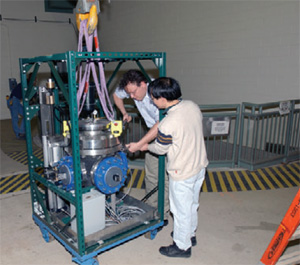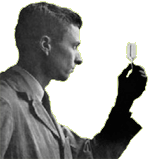Bubble chambers, once at the forefront of particle detection and then relegated to the history books, are coming back. On March 28, 2005, researchers at Fermilab and the University of Chicago lowered the first of a new generation of bubble chambers into the MINOS gallery at Fermilab in an effort to detect elusive dark matter. Juan Collar and Andrew Sonnenschein of the University of Chicago, in association with Fermilab's Mike Crisler, designed the compressed, CF3I-filled chamber, which is about the size of a bowling ball (photo right). Giving encouragement along the way was Roger Hildebrand, a pioneer of bubble chamber technology in the early 1950s (left).
Now 83 years old and with four grown children, eight grandchildren, and two greatgrandchildren, Hildebrand is investigating far-infrared astronomy and has no plans on slowing down. Is he trying to outdo his father, a renowned chemist who worked though his 90s? "I haven't set that as a goal," he chuckled. "I'm just curious about how nature works, and I'm trying to do the best job I can."
Click here to download the pdf version of this article. |








